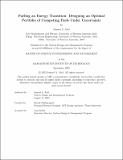Fueling an Energy Transition: Designing an Optimal Portfolio of Competing Fuels Under Uncertainty
Author(s)
Abel, Samuel A.
DownloadThesis PDF (1.280Mb)
Advisor
Mallapragada, Dharik
Terms of use
Metadata
Show full item recordAbstract
To facilitate the energy transition, firms must allocate their investment between incumbent and emerging fuel capacity. Understanding how to pace investment between competing energy options during this transition is crucial for energy companies and policymakers. Allocating investments among competing fuel technologies is complex due to uncertainty, improving costs of emerging fuels, market competition, and the delay between capacity investment and production.
To address this complexity, we develop a stochastic dynamic optimization model incorporating dynamic decision-making, Nash-Cournot equilibrium between competing firms, and
uncertainty of competing fuel parameters, such as hydrogen demand and technology improvements. The model is also the first, to our knowledge, to include technology learning rates in dynamic optimization models for energy markets with firms in Cournot competition. Learning rates are a critical factor in assessing cost improvements and competitiveness of
emerging fuels.
The model provides valuable insights for profit-driven firms and policymakers:
(1) Firms need to account for market structure and learning rates to optimize capital allocation
between fuels, as neglecting these factors can lead to sub-optimal immediate capacity investment decisions, and regret, measured as sub-optimal private gain.
(2) Incorporating stochastic modeling is also required for firms. We show that deterministic models lead to sub-optimal capacity investment decisions and increasing profit regret as the
uncertainty range increases.
We observe that learning rates can be complementary with carbon taxes and competition,
which has implications for policymakers:
(3) Encouraging market participation reduces fuel costs through learning. This increases investment in the emerging fuel by a greater amount than improved competition alone.
(4) Early implementation of carbon taxes can encourage capacity investment and production. We observe that under certain circumstances, with a sufficient learning rate, this early
implementation can reduce the need for stricter future taxes.
Date issued
2023-09Department
System Design and Management Program.Publisher
Massachusetts Institute of Technology